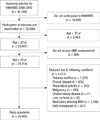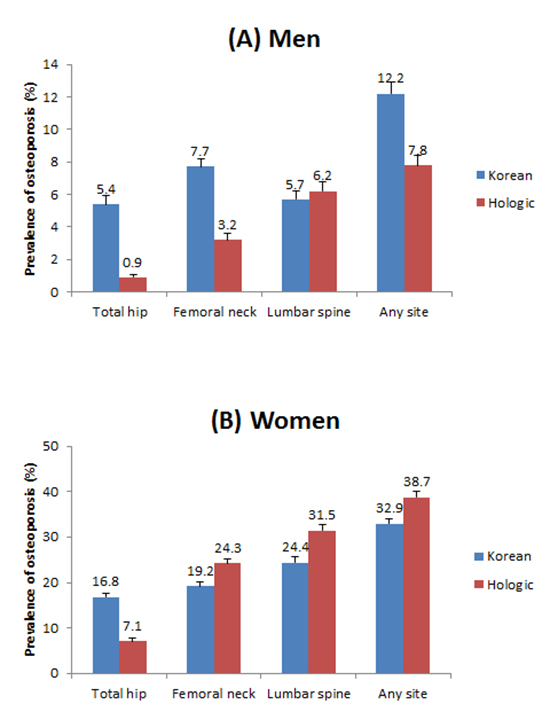1. Melton LJ 3rd. Who has osteoporosis? A conflict between clinical and public health perspectives. J Bone Miner Res. 2000; 15:2309–2314.
3. Assessment of fracture risk and its application to screening for postmenopausal osteoporosis. Report of a WHO Study Group. World Health Organ Tech Rep Ser. 1994; 843:1–129.
4. Looker AC, Melton LJ 3rd, Borrud LG, Shepherd JA. Lumbar spine bone mineral density in US adults: demographic patterns and relationship with femur neck skeletal status. Osteoporos Int. 2012; 23:1351–1360.
5. Wu XP, Liao EY, Huang G, Dai RC, Zhang H. A comparison study of the reference curves of bone mineral density at different skeletal sites in native Chinese, Japanese, and American Caucasian women. Calcif Tissue Int. 2003; 73:122–132.
6. Ho-Pham LT, Nguyen UD, Pham HN, Nguyen ND, Nguyen TV. Reference ranges for bone mineral density and prevalence of osteoporosis in Vietnamese men and women. BMC Musculoskelet Disord. 2011; 12:182.
7. Cheng XG, Yang DZ, Zhou Q, Zhuo TJ, Zhang HC, Xiang J, Wang HF, Ou PZ, Liu JL, Xu L, et al. Age-related bone mineral density, bone loss rate, prevalence of osteoporosis, and reference database of women at multiple centers in China. J Clin Densitom. 2007; 10:276–284.
8. Kin K, Kushida K, Yamazaki K, Okamoto S, Inoue T. Bone mineral density of the spine in normal Japanese subjects using dual-energy X-ray absorptiometry: effect of obesity and menopausal status. Calcif Tissue Int. 1991; 49:101–106.
9. Yang SO, Lee SK. Normative bone mineral density data by digital X-ray radiogrammetry in Korean men. J Korean Soc Osteoporos. 2009; 7:22–27.
10. Orimo H, Sugioka Y, Fukunaga M, Muto Y, Hotokebuchi T, Gorai I, Nakamura T, Kushida K, Tanaka H, Ikai T, et al. Diagnostic criteria of primary osteoporosis. J Bone Miner Metab. 1998; 16:139–150.
11. Simonelli C, Adler RA, Blake GM, Caudill JP, Khan A, Leib E, Maricic M, Prior JC, Eis SR, Rosen C, et al. Dual-energy X-ray absorptiometry technical issues: the 2007 ISCD official positions. J Clin Densitom. 2008; 11:109–122.
12. Wolter KM. Introduction to variance estimation. New York: Springer;1985.
13. Ribom EL, Ljunggren O, Mallmin H. Use of a Swedish T-score reference population for women causes a two-fold increase in the amount of postmenopausal Swedish patients that fulfill the WHO criteria for osteoporosis. J Clin Densitom. 2008; 11:404–411.
14. Mazess RB, Barden H. Bone density of the spine and femur in adult white females. Calcif Tissue Int. 1999; 65:91–99.
15. Zhang ZQ, Ho SC, Chen ZQ, Zhang CX, Chen YM. Reference values of bone mineral density and prevalence of osteoporosis in Chinese adults. Osteoporos Int. 2014; 25:497–507.
16. Marwaha RK, Tandon N, Kaur P, Sastry A, Bhadra K, Narang A, Arora S, Mani K. Establishment of age-specified bone mineral density reference range for Indian females using dual-energy X-ray absorptiometry. J Clin Densitom. 2012; 15:241–249.
17. Lee J, Lee S, Jang S, Ryu OH. Age-related changes in the prevalence of osteoporosis according to gender and skeletal site: the Korea National Health and Nutrition Examination Survey 2008-2010. Endocrinol Metab (Seoul). 2013; 28:180–191.
18. Iki M, Kagamimori S, Kagawa Y, Matsuzaki T, Yoneshima H, Marumo F. Bone mineral density of the spine, hip and distal forearm in representative samples of the Japanese female population: Japanese Population-Based Osteoporosis (JPOS) Study. Osteoporos Int. 2001; 12:529–537.
19. Kudlacek S, Schneider B, Peterlik M, Leb G, Klaushofer K, Weber K, Woloszczuk W, Willvonseder R. Normative data of bone mineral density in an unselected adult Austrian population. Eur J Clin Invest. 2003; 33:332–339.
20. Simmons A, Barrington S, O'Doherty MJ, Coakley AJ. Dual energy X-ray absorptiometry normal reference range use within the UK and the effect of different normal ranges on the assessment of bone density. Br J Radiol. 1995; 68:903–909.
21. Lau EM, Lynn H, Woo J, Melton LJ 3rd. Areal and volumetric bone density in Hong Kong Chinese: a comparison with Caucasians living in the United States. Osteoporos Int. 2003; 14:583–588.
22. Go SW, Cha YH, Lee JA, Park HS. Association between sarcopenia, bone density, and health-related quality of life in Korean men. Korean J Fam Med. 2013; 34:281–288.
23. Lee DR, Lee J, Rota M, Lee J, Ahn HS, Park SM, Shin D. Coffee consumption and risk of fractures: a systematic review and dose-response meta-analysis. Bone. 2014; 63:20–28.
24. Kim N, Choi HR, Kim SW, Kim BS, Won CW, Kim SY. Association between bone mineral density and sleep duration in the Korean elderly population. Korean J Fam Med. 2014; 35:90–97.
25. Henry MJ, Pasco JA, Korn S, Gibson JE, Kotowicz MA, Nicholson GC. Bone mineral density reference ranges for Australian men: Geelong Osteoporosis Study. Osteoporos Int. 2010; 21:909–917.
26. Looker AC, Wahner HW, Dunn WL, Calvo MS, Harris TB, Heyse SP, Johnston CC Jr, Lindsay RL. Proximal femur bone mineral levels of US adults. Osteoporos Int. 1995; 5:389–409.
27. Melamed A, Vittinghoff E, Sriram U, Schwartz AV, Kanaya AM. BMD reference standards among south asians in the United States. J Clin Densitom. 2010; 13:379–384.
28. Ahmed AI, Blake GM, Rymer JM, Fogelman I. Screening for osteopenia and osteoporosis: do the accepted normal ranges lead to overdiagnosis? Osteoporos Int. 1997; 7:432–438.
29. Delezé M, Cons-Molina F, Villa AR, Morales-Torres J, Gonzalez-Gonzalez JG, Calva JJ, Murillo A, Briceño A, Orozco J, Morales-Franco G, et al. Geographic differences in bone mineral density of Mexican women. Osteoporos Int. 2000; 11:562–569.
30. Wu XP, Liao EY, Zhang H, Dai RC, Shan PF, Cao XZ, Liu SP, Jiang Y. Determination of age-specific bone mineral density and comparison of diagnosis and prevalence of primary osteoporosis in Chinese women based on both Chinese and World Health Organization criteria. J Bone Miner Metab. 2004; 22:382–391.
31. Choi SH, Park IJ, Joo NS, Kim BT. Reference value for the T-score in osteoporosis diagnosis by health screening subjects. Korean J Bone Metab. 2008; 15:67–76.
32. Kanis JA, Glüer CC. An update on the diagnosis and assessment of osteoporosis with densitometry. Committee of Scientific Advisors, International Osteoporosis Foundation. Osteoporos Int. 2000; 11:192–202.
33. Cui LH, Choi JS, Shin MH, Kweon SS, Park KS, Lee YH, Nam HS, Jeong SK, Im JS. Prevalence of osteoporosis and reference data for lumbar spine and hip bone mineral density in a Korean population. J Bone Miner Metab. 2008; 26:609–617.
34. Kanis JA, Johnell O, Oden A, Jonsson B, De Laet C, Dawson A. Risk of hip fracture according to the World Health Organization criteria for osteopenia and osteoporosis. Bone. 2000; 27:585–590.
35. Kanis JA, McCloskey EV, Johansson H, Oden A, Melton LJ 3rd, Khaltaev N. A reference standard for the description of osteoporosis. Bone. 2008; 42:467–475.
36. Yoon HK, Park C, Jang S, Jang S, Lee YK, Ha YC. Incidence and mortality following hip fracture in Korea. J Korean Med Sci. 2011; 26:1087–1092.
37. Khosla S. Update in male osteoporosis. J Clin Endocrinol Metab. 2010; 95:3–10.
38. Abrahamsen B. Adverse effects of bisphosphonates. Calcif Tissue Int. 2010; 86:421–435.
39. Henzell S, Dhaliwal SS, Price RI, Gill F, Ventouras C, Green C, Da Fonseca F, Holzherr M, Prince R. Comparison of pencil-beam and fan-beam DXA systems. J Clin Densitom. 2003; 6:205–210.









 PDF
PDF ePub
ePub Citation
Citation Print
Print






 XML Download
XML Download